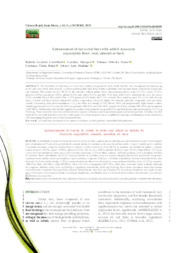Embrapa Florestas
 Busca de publicações
Busca de publicações
Enhancement of oat cereal bars with added Araucaria angustifolia flour: seed, almond or bark.
Autoria: CASTRILLON, R. G.; MARQUES, C.; FARIAS, F. O.; HELM, C. V.; MATHIAS, A. L.
Resumo: ABSTRACT: The feasibility of enhancing oat cereal bars, widely recognized for their health benefits, was investigated by replacing up to 5% oats with whole seed, almond, or steam-cooked pinhão husk flour. Pinhão contributes with resistant starch, antioxidant compounds, and minerals. The control oat bar (30.5% of the mixture), without pinhão flours but containing brown sugar (25.5%), raisins (15.0%), glucose (15.0%), coconut oil (3.0%), gelatin (0.5%), and water (10.0%), provides 75.53 kcal, with 15.66% carbohydrates (on a dry basis), 2.88% insoluble fiber, 0.70% soluble fiber, 1.82% protein, 0.62% lipids, and 0.32% minerals. Bars replacing up to 5% of oats with almond, husk, or whole seed flour showed statistically similar compositions, except for lipids, few minerals, phenolic compounds, and antioxidant activity. Concerning daily recommendations, a 22 g bar offers low energy (3.78%, Brasil, 1998) and proportionally high mineral content, including potassium (34.64%), zinc (81.58%), magnesium (108.55%), iron (421.18%), copper (192.98%), calcium (395.13%), and manganese (1,027.00%). Additionally, they exhibit a significant content of total phenolic compounds (8.66 mg GAE/g) and antioxidant capacity (24.43 mg Trolox/g). These innovative bars were well-received in sensory evaluations and demonstrated good commercial potential. Notably, a bar that replaced 5% oats with husk flour could be a viable option for microenterprises due to simplified technology, contributing to waste valorization and encouraging the preservation of the Araucaria Forest.
Ano de publicação: 2024
Tipo de publicação: Artigo de periódico
Unidade: Embrapa Florestas

